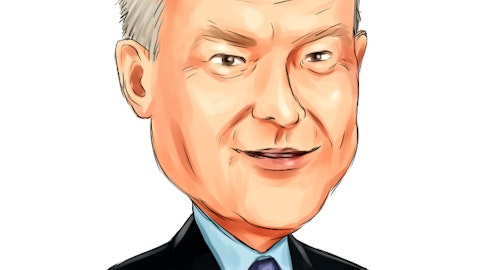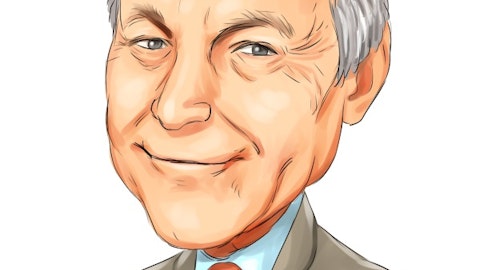UniFirst Corporation (NYSE:UNF) Q2 2023 Earnings Call Transcript March 29, 2023
Operator: Greetings, and welcome to the UniFirst Corp. Second Quarter Earnings Call. During the presentation, all participants will be in a listen-only mode. Afterwards, we will conduct a question-and-answer session. I would now like to turn the conference over to the President and CEO, Mr. Steven Sintros. Please go ahead.
Steven Sintros: Thank you, and good morning. I’m Steven Sintros, UniFirst ‘s President and Chief Executive Officer. Joining me today is Shane O’Connor, Executive Vice President and Chief Financial Officer. We would like to welcome you to UniFirst Corporation’s conference call to review our second quarter results for fiscal year 2023. The call will be on a listen-only mode until we complete our prepared remarks, but first, a brief disclaimer. This conference call may contain forward-looking statements that reflect the Company’s current views with respect to future events and financial performance. These forward-looking statements are subject to certain risks and uncertainties. The words anticipate, optimistic, believe, estimate, expect, intend and similar expressions that indicate future events and trends identify forward-looking statements.
Actual future results may differ materially from those anticipated depending on a variety of risk factors. For more information, please refer to the discussion of these factors these risk factors in our most recent Form 10-K and 10-Q filings with the Securities and Exchange Commission. We are pleased with our strong top-line performance in the quarter which was partially fueled by our ongoing efforts to mitigate the cost pressures that we’ve been experiencing in our business. As always, I want to thank our over 14,000 team partners who continue to always deliver for each other and our customers. We are also pleased with the progress we are making advancing our technology and infrastructure initiatives. As we have discussed, we continue to be focused on making long-term investments in our business designed to accelerate growth and profitability, as well as ensure we are providing industry-leading services for years to come.
Consistent with the theme of making long-term investments, I am happy to announce that on March 13, we successfully closed our previously announced purchase of Clean Uniform and officially welcome the Clean team and their customers into the UniFirst family. Founded in 1938, and headquartered in St. Louis Missouri, Clean is one of the largest independent uniform workwear and facility service program providers in the United States with locations servicing Missouri, Illinois, Arkansas, Kansas and Oklahoma. Over the years, Clean has built a highly respected business with a market-leading reputation for quality service with a strong customer focus. We believe that the combination of the two companies will provide a foundation for us to deliver an enhanced service experience for all customers in the markets that we serve together.
Due to the strong leadership and service reputation that Clean brings with it, as well as the complexities of where we are in our technology transformation, we will be strategic and patient in the integration of the two businesses to minimize the impacts and risks on Clean’s most valuable assets, its employees and its customers. Currently, the Clean business is operating at an EBITDA margin of approximately 10%. We believe that over the next two to three years, we will be able to more than double that performance as we bring the companies together. Shane will provide more details shortly regarding the impact we expect Clean to have on our fiscal 2023 operating results shortly. As we’ve discussed in prior calls, we continue to be focused on three large initiatives designed to transform the company in terms of overall capabilities and competitive positioning.
These initiatives are the rollout of our new CRM system, a corporate-wide ERP system and investments in the UniFirst brand. The last several quarters we have reconciled the impact of these initiatives out of our operating results, so that investors could get a better perspective of our performance excluding these costs related to these transformational projects. Based on new guidance provided by the Securities and Exchange Commission regarding non-GAAP financial measures and a comment from the SEC in a recent SEC comment letter we are going to be modifying our disclosure going forward and no longer providing adjusted operating results excluding these costs. We will however generally continue to provide disclosure in quantification of these initiative cost, so investors can clearly understand the impact that they are having on our overall results and profitability.
With respect to our CRM systems project, we are making good progress deploying our new system in line with our internal schedule. As of today, we have deployed approximately 75% of our U.S. core laundry locations and we expect the remaining U.S. locations to be deployed by the end of fiscal 2023. The deployment of our smaller Canadian and cleanroom operations will carry over into fiscal 2024. Over the remainder of fiscal 2023, we will also continue to be focused on the global design phase of our ERP project. The implementation of our new Oracle Cloud ERP will be a multi-year initiative designed to transform our supply chain and procurement capabilities, as well as provide an overall technology foundation for growth and efficiency. All of our investments are designed to deliver solid long-term returns for UniFirst stakeholders in our integral components of our primary long-term objective to be universally recognized as the best service provider in our industry.

Photo by sol on Unsplash
As we continue to go through the fiscal 2023, we will be watching the dynamic market conditions closely. During the quarter, we did not see a significant change to the operating environment and where a level that our customers have been stable. When and what the impact higher interest rates will have on our customer base and the overall market remain to be seen. Over the years, our business has proved resilient in many different economic cycles in regardless of what the next cycle brings, we are confident in our ability to execute against our plan. We are pleased with the execution of our team which continues to deliver solid performances in both new account sales, as well as customer retention. Continuing the trend from prior years, the strong revenue growth also reflects the impact of price adjustments from throughout the year as we work with customers to sharing cost increases we have experienced related to the inflationary environment.
We will continue to manage cost in areas we can control while assuring that we don’t impact our ability to execute on our transformational initiatives or adversely affect our customer service levels. And as always we will maintain a sharp focus on taking care of our employees, our customers and bringing new customers into the UniFirst family. With that, I’ll turn the call over to Shane, who will provide more details on our second quarter results.
Shane O’Connor: Thanks, Steve. In our second quarter of 2023, consolidated revenues were $542.7 million, up 11.5% from $486.7 million a year ago, and consolidated operating income decreased to $20.7 million from $22.6 million or 8.4%. Net income for the quarter decreased to $17.8 million or $0.95 per diluted share from $18.5 million or $0.97 per diluted share. Our financial results in the second quarters of fiscal 2023 and 2022 included approximately $9.1 million and $6.7 million, respectively, of costs directly attributable to the three key initiatives that Steve discussed. In addition, we incurred costs related to the acquisition of Clean Uniform during the second quarter of fiscal 2023 of approximately $2 million. The effect of these items on the second quarters of fiscal 2023 and 2022 combine to decrease operating income by $11.1 million and $6.7 million, respectively, net income by $8.3 million and $5.1 million, respectively and EPS by $0.44 and $0.27, respectively.
Our Core Laundry Operations revenues for the quarter were $477.1 million, up 10.2% from the second quarter of 2022. Core Laundry organic growth, which adjusts for the estimated effect of acquisitions, as well as fluctuations in the Canadian dollar was 10.1%. This strong organic growth rate was primarily the result of strong pricing efforts over the last year to share with our customers the cost increases that we have incurred in our business due to the ongoing inflationary environment, as well as continued solid sales performance and customer retention. Core Laundry operating margin decreased to 2.9% for the quarter or $13.6 million from 4.3% in prior year or $18.7 million. The costs we incurred related to our key initiatives and the Clean acquisition were recorded to the Core Laundry Operations segment and combine to decrease the Core Laundry operating margin for the second quarter of fiscal 2023 and 2022 by 2.3% and 1.6% respectively.
Excluding these items, the segment’s operating margin continues to be impacted by increase in merchandize costs resulting from the inflationary effects on our cost of our products, as well as higher levels of merchandize put in service with our customers in 2022 to support solid new account sales, increased activity in our energy-dependent markets, elevated wear additions at our customers, as well as certain national account investments. Partially offsetting these headwinds was lower healthcare and casualty claims expense during the quarter compared to prior year. Energy cost increased to 4.8% of revenues in the second quarter of 2023, up from 4.7% in 2022. Revenues from our Specialty Garments segment, which delivers specialized nuclear decontamination and cleanroom products and services, increased to $42.1 million from $35.5 million in prior year or 18.5%.
This increase was primarily due to strong growth in our cleanroom operations, and increased project work in our North American nuclear operations. The segment’s operating margin increased to 19.1% from 10.8%, primarily the result of its strong top-line performance. The segment’s operating performance from both a top-line and profitability perspective was very strong in what is normally a seasonally down quarter and exceeded our expectations. As we’ve mentioned in the past, this segment’s results can vary significantly from period to period due to seasonality and the timing of nuclear reactor outages and projects that require our specialized services. Our First Aid segment’s revenues increased to $23.5 million from $18.1 million in prior year or 29.9% with both the wholesale distribution and van operations contributing to the growth.
However, the segment had an operating loss of $1 million during the quarter. These results reflect our continued investment in expanding the First Aid van business and building out the infrastructure necessary to eventually support a much larger business. At the end of our second fiscal quarter, we continued to reflect a solid balance sheet and financial position with no long-term debt and cash, cash equivalents and short-term investments totaling $345.1 million. We did not repurchase any additional common stock under our current stock repurchase program during the quarter. Cash provided by operating activities for the first half of the year increased to $64.2 million, compared to $44.9 million in prior year, primarily due to lower working capital needs of the business.
We continue to invest in our future with capital expenditures during the period of $74.8 million and the acquisition of four businesses for which we paid $7.1 million. As Steve mentioned, on March 13, we closed on our previously announced purchase of Clean Uniform for an aggregate purchase price of approximately $300 million. This acquisition was financed with our cash reserves and availability under our existing line of credit. As a result of this acquisition, on March 9, we exercised the accordion feature of our existing credit agreement, which increased the aggregate commitments under the credit agreement by $100 million resulting in a total commitment of $275 million. Our current assumptions regarding the impact of the Clean acquisition on our operating results for the year, which will be recorded to the Core Laundry operations include an increase in revenues of $42 million, a decrease in operating income of $0.5 million, which includes $3 million of purchase-related intangible amortization expense and acquisition-related expenses of $4 million, which includes the $2 million expense in our second quarter of 2023.
I would like to highlight that we have estimated the impact of the purchase price accounting on Clean’s operating results, using assumptions from due diligence, but we’ll need to confirm and update if necessary those assumptions as we finalize the purchase accounting process. I’d like to take this opportunity to provide an update on our outlook which now includes the assumed impact of the Clean acquisition. At this time, we expect our full year consolidated revenues will be between $2.21 billion and $2.22 billion. And our diluted earnings per share will be between $5.02 and $5.37. This revised guidance also assumes our Core Laundry operation’s operating margin at the midpoint of the range of 5.2%. An estimate of $40 million of costs directly attributable to our key initiatives, as well as $4 million of Clean-related acquisition costs.
These two items combined to decrease the Core Laundry operation’s operating margin assumption by 2.2% and EPS by $1.76. Our revised guidance reflects continued pressures impacting our Core Laundry operations, most notably, merchandize costs, which are being partially offset by a stronger than previously expected operating performance during the quarter in our Specialty Garments business. Our revised guidance further assumes an effective tax rate for fiscal 2023 of 25% and does not assume any future share buybacks or unexpected significantly adverse economic developments. This concludes our prepared remarks, and we would now be happy to answer any questions that you might have.
See also 25 Highest Paying Jobs in the World Without a Degree and 13 Best Medical Stocks To Invest In.
Q&A Session
Follow Unifirst Corp (NYSE:UNF)
Follow Unifirst Corp (NYSE:UNF)
Operator: Our first question comes from Andrew Steinerman with JP Morgan. Please proceed.
Andrew Steinerman : Hi, Shane. I was hoping you could break down the $9.1 million into the three key initiatives in the quarter. And then also give us a sense of what the cost related to the three key initiatives will be in the second half of the year. And if it’s okay, I’m just going to get my second question as well. Do you have a sense yet when the or Oracle Cloud ERP system will go into deployment, meaning starting deployment?
Shane O’Connor: Yeah, sure. So I’ll start with the breakout of the key initiatives for the quarter, as well as the expectations for the remainder of the year. So, for the quarter, about two-thirds of those costs really related to the CRM project, most notably the deployment of that system. I think as we’ve spoken about in the past, right now, we are deploying that system to our locations and we have numerous teams that are going and supporting our locations throughout that deployment. When I take a look at the costs that I’m going to incur throughout the remainder of the year, similar assumption on the CRM cost about two-thirds of the cost for the year will be supporting that deployment as well. Largely, we’re going to be the lion’s Share of the cost related to the deployment will be throughout the remainder of this fiscal year – by the end of the fiscal year.
Our expectation is that our domestic locations will be largely deployed. Some of those costs will carry into 2024 as we as we continue to deploy some of our cleanroom in Canadian locations. But the majority of the costs related to the CRM deployments will take place in this fiscal year. Right now, when you take a look at the other two initiatives, the majority of that one-third at this point in time is the ERP cost. And again for the remainder of the year, the remainder of the one-third is ERP as well. My quarterly experience, CRM, ERP and then some residual branding carrying over from last year when we spent the majority of the cost supporting that initiative, my quarterly breakout was very, very similar. What I’m expecting for the full year.
Steven Sintros : The only thing I’ll add to that, Andrew, is that the branding is – Shane, mentioned the branding work having some tale of cost into this year. That’ll continue to reduce over the next couple of quarters.
Andrew Steinerman : Okay.
Steven Sintros : And as far as the ERP, the ERP project is still very early on in that project right now. We are largely involved in in design work – in designing the system and how it’s going to interface with other ancillary systems that support our business. That’ll be going on throughout the remainder of the year. And coming out of that design work, we will also be finalizing the timeline and the roadmap for the deployment of the different modules. But we expect that will the deployments and the implementation of that system will be over a number of years. Because since we haven’t finalized that roadmap and we will be working the remainder of this year to do that at this point in time, I can’t definitively say exactly when that deployment is going to take place. We do expect that it will be a multi-year project.
Andrew Steinerman : Understood. Thanks for the time.
Shane O’Connor: Thank you.
Operator: Our next question comes from Andy Wittmann with Baird. Please proceed.





